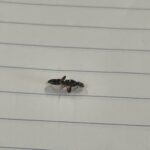Sample information |
|
| Picture |

|
|---|---|
| Location | |
| Collection date | 09/16/2024 |
| Captive / Cultivated? | Wild-caught |
| Group | Bluegrass Community and Technical College |
| Observations | The specimen was collected using a flying insect trap containing banana peels and vinegar per the Arthropod Collection Traps Guide provided by the Wolbachia Project. The trap was hung from a tree branch adjacent to a small creek in a suburban backyard for two days. The trap was cut open and the (predominantly flying) insects were removed and preserved in 70% alcohol. The trap was then placed on the ground for an additional three days capturing additional insects. These insects included both crawling and flying insects. These insects were removed and preserved in 70% alcohol. The specimen was identified as a bee (Anthophila) using the iNaturalist app. |
| Putative identification | Arthropoda Insecta Hymenoptera |
Methods |
|
| Extraction kit | DNeasy (Qiagen) blood and tissue kit |
| DNA extraction location | Abdomen |
| Single or Duplex PCR | Duplex Reaction |
| Gel electrophoresis system | Standard electrophoresis system |
| Buffer | TBE |
| DNA stain | SYBR Safe |
| Gel images |

|
| Protocol notes | GoTaqGreen polymerase was used. Reaction conditions were per Lab 3: PCR (Wolbachia Project Guide) for duplex reaction PCRs. The PCR reaction volume was 25 uL. 10 uL of each reaction was run on a 2% agarose gel. The relevant lane (lane 3), for the specimen #28 is boxed. |
Results |
|
| Wolbachia presence | No |
| Confidence level | High |
| Explanation of confidence level | No PCR product of ~440 bp (which is the correct size for the Wolbachia product) was produced. A~700 bp (correct size for the CO1 product) was produced, indicating the DNA isolated from the specimen is of suitable quality for PCR. All control reactions (Lanes 6 through 10) worked as they should. The positive control is DNA extracted from a control insect infected with Wolbachia, while the negative control is DNA extracted from an uninfected insect. Both controls were provided by the Wolbachia Project. |
| Wolbachia 16S sequence |
The PCR product was not sequenced.
BLAST at The Wolbachia Project BLAST at NCBI
|
| Arthropod COI sequence |
The PCR product was not sequenced.
BLAST at The Wolbachia Project BLAST at NCBI
|
| Summary | The Hymenoptera was found to be negative for Wolbachia. |
 European Paper Wasp
European Paper Wasp Woodworm Ant
Woodworm Ant